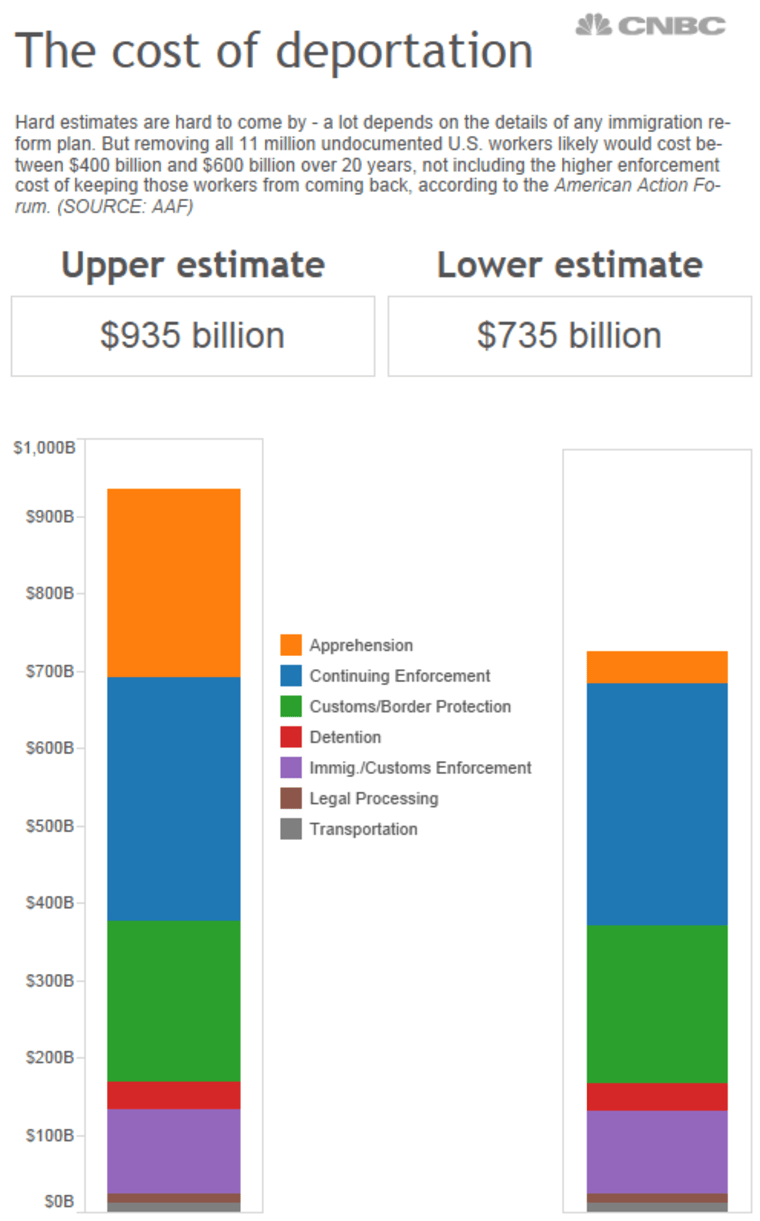There's no shortage of ideas about how to fix the broken U.S. policy on immigration.
But the heated political debate over undocumented workers often comes up short on a critical question: What would these solutions cost?
Because millions of undocumented workers seek to keep a low profile, the economic impact of their presence — and the cost of removing them — is difficult to pin down.
But the cost would be huge. By one estimate, removing the entire population of undocumented workers now in the U.S. would wipe out a chunk of the American economy roughly the size of the annual gross domestic product of Texas.
Of the 41 million foreign-born people living in the United States in 2012, about 22 million were noncitizens, according to a Congressional Budget Office analysis of Census data. That noncitizen category includes lawful permanent residents (who are legally allowed to live and work here); temporary residents and visitors, and unauthorized residents. That last category includes some 11 million to 12 million people, a number that has stayed fairly constant, the CBO researchers said.

As the 2016 presidential election approaches, conservative candidates have been proposing tough measures to reduce that number, in some cases to zero through an aggressive deportation campaign.
The most vocal proponent — leading Republican candidate Donald Trump — has proposed various measures, including mass deportations, seizure of remittance payments made with illegal wages, raising fees on temporary visas issued to Mexican CEOs and diplomats and other measures.
"They are responsible for this problem, and they must help pay to clean it up."
Trump has also proposed demanding payment from the Mexican government
"The Mexican government has taken the United States to the cleaners," Trump said in a position paper on immigration. "They are responsible for this problem, and they must help pay to clean it up."
It's tough to estimate just how big a bill Trump plans to send to Mexico City — a lot depends on the specific details of any deportation plan. But some researchers have taken a run at the question.
In March, the American Action Forum, a center-right policy institute led by former CBO director Douglas Holtz-Eakin, estimated it would take between $100 billion and $300 billion to arrest and remove "all undocumented immigrants residing in the country, a process that we estimate would take 20 years," the group said.
Once those undocumented immigrants had been removed, it would take another $315 billion in higher enforcing costs to keep them from coming back, according to AAF.
What Donald Trump's Immigration Plan Means
That estimate includes just the hard cost of removing undocumented workers; it doesn't take into account the economic impact that would result from the removal of some 11 million people from the labor force and the resulting loss of consumer spending.
AAF estimated the removal of that many people would shrink the pool of U.S. workers by 6.4 percent, which means that 20 years from now the U.S. economy would be nearly 6 percent cent smaller. That works out to a loss of $1.6 trillion in lost wages, spending and other economic activity.
To put that in perspective, the gross domestic product for Texas last year was about $1.5 trillion, second behind California.
While this impact would be felt across the country and throughout the economy, sectors such as agriculture, construction, retail and hospitality would be hardest hit, the AAF report.
The federal government would also be a big loser if all undocumented workers were removed from the country, according to a 2013 CBO report. The CBO was asked to estimate the economic impact of S. 744, a comprehensive immigration reform bill that passed the Senate before being scuttled in the House.
Because legal workers would be entitled to a range of federal benefits, including subsidized health care, direct federal spending would rise by $262 billion over the decade beginning in 2014, the report said. Most of that would go to pay higher health-care costs.
But the immigration reform plan spelled out in S. 744 would more than offset those costs, thanks to much higher tax collections, both because the workforce would expand and undocumented workers would now pay taxes. Those higher tax receipts would boost federal revenues by $459 billion over the same decade, the CBO estimated.
That would add a net of $197 billion to the federal budget, shrinking the deficit by that much over 10 years.
Those estimates don't include the impact of more workers paying into the Social Security trust fund, which would collect billions more in payroll taxes that would put it on a more solid financial footing.
